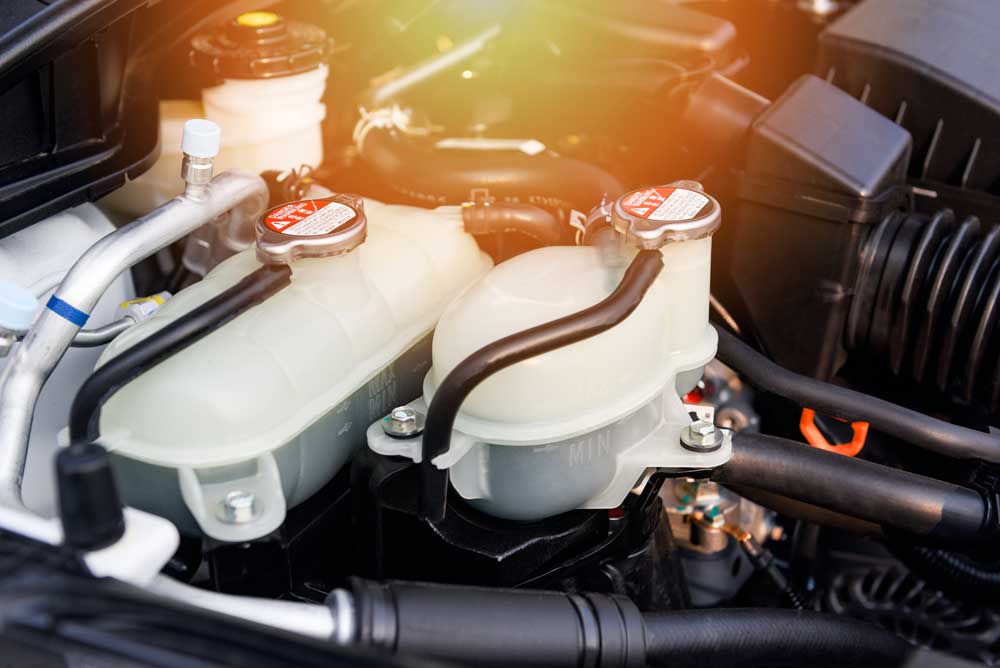
Picture this situation: You are driving in the Nevada desert, headed to Las Vegas for the weekend. Suddenly, your engine temperature dial spikes and smoke begins to issue out from under the hood. There is a strong smell of burning oil, a result of a leaky head gasket from a warped cylinder in the engine block. You pull over to the side of the road, fervently hoping that you have enough cell reception to call for a tow to the nearest car repair shop.
This is, unfortunately, an all-too-common occurrence for people who have ignored their engine’s coolant levels or who have failed to notice a leak of some kind. While overheating remains a constant threat for all cars—especially for those in desert locales like Utah and Nevada—a lack of coolant can also be a big detriment to engines in the middle of winter as well. In an effort to help our friends and neighbors who frequent our West Valley car repair center, let’s discuss the ins and outs of antifreeze and coolant.
Antifreeze, Coolant, and Your Engine
Any heat-generating apparatus, whether it be an engine, a circuit board, or your own heart, will need a cooling agent to distribute, and eventually disperse that heat. If not, the component in question will overheat and essential parts will melt or shut down. Generally speaking, nature’s means of providing relief from the heat has always been water, which is why we are always subconsciously reaching for a glass of something cold when we’re sweating. Your car’s engine needs a way to counteract the immense build-up of heat that it generates or else you’ll find yourself stranded on that Navadan roadside.
Enter the engine coolant. One of the essential fluids of the car, coolant is a mixture of antifreeze and water and it is used both to cool the engine and keep it from freezing. In order to answer this seeming contradiction of uses, let’s take a look at the science.
- Engine coolant is made up of antifreeze, a glycol-based substance, and water.
- Normally, water boils at 212℉ and freezes at 32℉ but with a 50/50 antifreeze/water mixture in the coolant, the boiling point reaches 223℉ and the freezing point lowers to -35℉.
- By mixing antifreeze into the water, the water’s molecules act differently in relation to one another and will no longer be willing to so easily slow down and cling to each other, as is what happens when water freezes. This is known as a “colligative” effect because solvent molecules affect the structure of the water.
- This is why ice melt is so popular in Utah. By dissolving salt in water, it inhibits the water molecules from joining together and freezing.
Thanks to the colligative properties of water, coolant is able to keep the engine both cool enough in the summer and warm enough in the winter, prolonging your engine’s lifespan and keeping you mobile regardless of the weather.
Your Cooling System
As has been discussed, when your engine is out of coolant it can lead to disastrous outcomes. As such, our West Valley car repair center takes maintaining your cooling system very seriously. But how does the coolant actually work within the car?
- Your cooling system will circulate coolant through fluid lines within the engine block, using the liquid to siphon off heat from the engine.
- As this occurs, the coolant will heat up even as the engine cools. The coolant is then pushed through the lines into the radiator.
- Once in the radiator, outside air rushing in through the grill of the car will cool the liquid once more, making it usable again to help the engine.
- The cooling system then recycles the cooled-down fluids and cycles them back into the engine block, repeating the process.
At Master Muffler, we have extensive experience with the cooling systems of virtually every make and model. Our West Valley car repair shop, especially, can help you repair any damage caused either by melted parts from the engine overheating or the burst and broken components affected by freezing temperatures.
Related Posts
Key Takeaways On average, passenger vehicle tires last 40,000 to 60,000 miles, depending on type, driving habits, and maintenance. Replace tires when tread depth reaches 2/32”, if damaged, or older than 10 years. Regular rotation, alignment, and proper inflation extend tire life. Aggressive driving, poor roads, and harsh weather shorten tire lifespan. Take advantage [...]
When you think about car maintenance, you probably focus on oil changes, tire rotations, and maybe even brake pad replacement. But what about your brake fluid? If you’ve ever wondered, “What does brake fluid do?” or “Why is brake fluid important?”, you’re not alone. Brake fluid might not be the most talked-about part of [...]
Is that high-pitched squeal from your brakes driving you—and everyone else—crazy? Don’t ignore it. Squeaky brakes aren’t just annoying, they’re your car’s way of saying something needs attention. Whether you're cruising through Salt Lake City or winding up Idaho’s mountain passes, here’s what’s likely going on, how you can fix it, and when it [...]





